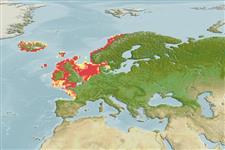Actinopterygii (ray-finned fishes) >
Gadiformes (Cods) >
Lotidae (Hakes and burbots)
Etymology: Ciliata: Latin, cilium = eye lid, eye lash (Ref. 45335).
Environment / Climate / Range
Ecology
Marine; brackish; demersal; oceano-estuarine (Ref. 57987); depth range 10 - 90 m (Ref. 1371), usually 10 - 50 m (Ref. 35388). Temperate, preferred ?; 70°N - 44°N, 24°W - 22°E
Northeast Atlantic: around the British Isles and northward along the European coasts to northern Norway. Also found at the Faeroe Islands and Iceland.
Length at first maturity / Size / Weight / Age
Maturity: Lm 6.2 range ? - ? cm
Max length : 20.0 cm TL male/unsexed; (Ref. 1371)
Dorsal
soft rays
(total): 48-51;
Anal
spines: 0;
Anal
soft rays: 41 - 43. Head relatively large, less than five times in SL. Skin fold above the upper lip with three pairs of lobes or small barbels. First fin ray followed by a row of small, fleshy filaments (Ref. 1371). One barbel on the lower jaw and four on the snout (Ref. 35388).
Found in the sublittoral zone, on sand or mud bottoms. Feed mostly on decapod crustaceans, lobsters, crabs, mysids and polychaetes (Ref. 3663). Oviparous (Ref. 205). Spawning may take place in deeper waters (Ref. 57987).
Probably pairs up during breeding (Ref. 205).
Cohen, D.M., T. Inada, T. Iwamoto and N. Scialabba, 1990. FAO species catalogue. Vol. 10. Gadiform fishes of the world (Order Gadiformes). An annotated and illustrated catalogue of cods, hakes, grenadiers and other gadiform fishes known to date. FAO Fish. Synop. 125(10). Rome: FAO. 442 p. (Ref. 1371)
IUCN Red List Status (Ref. 115185)
CITES (Ref. 94142)
Not Evaluated
Threat to humans
Harmless
Human uses
Fisheries: commercial
More information
ReferencesAquacultureAquaculture profileStrainsGeneticsAllele frequenciesHeritabilityDiseasesProcessingMass conversion
Tools
Special reports
Download XML
Internet sources
Estimates of some properties based on models
Phylogenetic diversity index (Ref.
82805): PD
50 = 0.6250 [Uniqueness, from 0.5 = low to 2.0 = high].
Bayesian length-weight: a=0.00741 (0.00451 - 0.01218), b=3.17 (3.03 - 3.31), in cm Total Length, based on LWR estimates for this species & (Sub)family-body (Ref.
93245).
Trophic Level (Ref.
69278): 3.5 ±0.44 se; Based on food items.
Resilience (Ref.
69278): High, minimum population doubling time less than 15 months (tm=1; tmax=3).
Vulnerability (Ref.
59153): Low vulnerability (17 of 100) .
